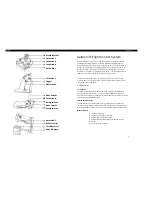
DKG-255 User Manual Firmware V-1.0
- 25 -
The actuator is inoperative:
1) Measure the DC-supply voltage between terminals C(+) and D(-) of the unit. You should read
the battery voltage, if not:
a) Check for a blown fuse
b) Check connections and wiring
2) With the unit powered-up, momentarily connect terminals B and C. The actuator should
open completely. If not:
a) Check a mechanical obstruction on the actuator lever manually.
b) Measure the DC voltage on the actuator terminals:
If the battery voltage is present, then the actuator is damaged.
If there is no voltage, then check the actuator wiring.
c) If the fuse blows, then check a short circuit in the wiring.
3) Crank the engine. Measure the AC voltage between terminals E and F. It should be at
least 1VAC_RMS. If not:
a) Check the gap between the speed sensor and the gear teeth. If needed then readjust it.
b) Check wiring.
c) The speed sensor may be defective.
4) Crank the engine. Measure the DC battery voltage while cranking. It should be above
8 VDC for a 12V system and 16V for a 24V system. If below:
a) The battery is weak or discharged.
5) If the battery voltage is correct:
a) Speed adjustment is set too low, readjust.
b) The unit is defective.
The engine speed is too low:
1) Check the speed setting.
2) While engine running under governor control, measure the DC voltage between
terminals A and B. If the voltage is close to the battery voltage:
a) the actuator lever is mechanically obstructed from moving until full fuel position. Check
mechanically that the lever has enough freedom of movement.
b) The spring mechanical resistance is too strong for the actuator. Check with a softer spring.
c) Check for misalignments and frictions on the actuator-fuel lever systems.
Below is a basic list of most often encountered
troubles. More detailed investigation may be
required in some cases.
15. TROUBLESHOOTING GUIDE


































